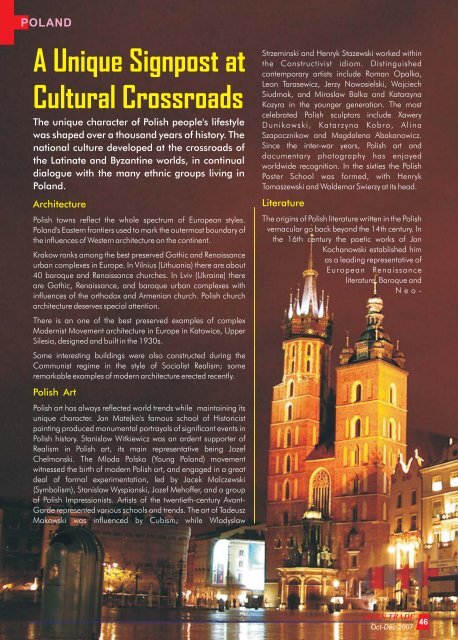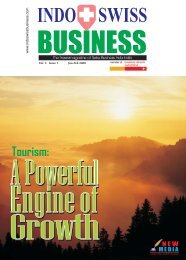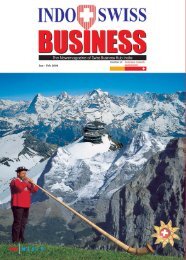pele SciaSction - new media
pele SciaSction - new media
pele SciaSction - new media
Create successful ePaper yourself
Turn your PDF publications into a flip-book with our unique Google optimized e-Paper software.
POLAND<br />
A Unique Signpost at<br />
Cultural Crossroads<br />
The unique character of Polish people's lifestyle<br />
was shaped over a thousand years of history. The<br />
national culture developed at the crossroads of<br />
the Latinate and Byzantine worlds, in continual<br />
dialogue with the many ethnic groups living in<br />
Poland.<br />
Architecture<br />
Polish towns reflect the whole spectrum of European styles.<br />
Poland's Eastern frontiers used to mark the outermost boundary of<br />
the influences of Western architecture on the continent.<br />
The origins of Polish literature written in the Polish<br />
vernacular go back beyond the 14th century. In<br />
the 16th century the poetic works of Jan<br />
Kochanowski established him<br />
as a leading representative of<br />
European Renaissance<br />
literature. Baroque and<br />
Neo-<br />
Krakow ranks among the best preserved Gothic and Renaissance<br />
urban complexes in Europe. In Vilnius (Lithuania) there are about<br />
40 baroque and Renaissance churches. In Lviv (Ukraine) there<br />
are Gothic, Renaissance, and baroque urban complexes with<br />
influences of the orthodox and Armenian church. Polish church<br />
architecture deserves special attention.<br />
There is an one of the best preserved examples of complex<br />
Modernist Movement architecture in Europe in Katowice, Upper<br />
Silesia, designed and built in the 1930s.<br />
Some interesting buildings were also constructed during the<br />
Communist regime in the style of Socialist Realism; some<br />
remarkable examples of modern architecture erected recently.<br />
Polish Art<br />
Polish art has always reflected world trends while maintaining its<br />
unique character. Jan Matejko's famous school of Historicist<br />
painting produced monumental portrayals of significant events in<br />
Polish history. Stanislaw Witkiewicz was an ardent supporter of<br />
Realism in Polish art, its main representative being Jozef<br />
Chelmonski. The Mloda Polska (Young Poland) movement<br />
witnessed the birth of modern Polish art, and engaged in a great<br />
deal of formal experimentation, led by Jacek Malczewski<br />
(Symbolism), Stanislaw Wyspianski, Jozef Mehoffer, and a group<br />
of Polish Impressionists. Artists of the twentieth-century Avant-<br />
Garde represented various schools and trends. The art of Tadeusz<br />
Makowski was influenced by Cubism; while Wladyslaw<br />
Strzeminski and Henryk Stazewski worked within<br />
the Constructivist idiom. Distinguished<br />
contemporary artists include Roman Opalka,<br />
Leon Tarasewicz, Jerzy Nowosielski, Wojciech<br />
Siudmak, and Miroslaw Balka and Katarzyna<br />
Kozyra in the younger generation. The most<br />
celebrated Polish sculptors include Xawery<br />
Dunikowski, Katarzyna Kobro, Alina<br />
Szapocznikow and Magdalena Abakanowicz.<br />
Since the inter-war years, Polish art and<br />
documentary photography has enjoyed<br />
worldwide recognition. In the sixties the Polish<br />
Poster School was formed, with Henryk<br />
Tomaszewski and Waldemar Swierzy at its head.<br />
Literature<br />
OPEN TRADE 46<br />
Oct-Dec 2007

















